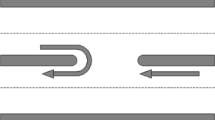Abstract
The present study mainly focuses on estimating driver’s gap acceptance parameters such as critical gap and follow-up headways. In addition, meta-analysis was also carried out to compare critical gap values for different vehicle classes obtained from various studies in India. The data were collected and analysed for three different roundabouts located in Chanakyapuri, New Delhi, India. Results indicate that the critical headway and weighted follow-up headway values are significantly lower than that recommended by HCM 2010 and higher than that of Indo-HCM 2017. It is also observed that the distribution of critical gap and follow-up headways of different vehicle classes are mostly skewed. This inconsistencies in the critical gap and following headways may be due to different traffic conditions, vehicle composition and driver behavior. Further, the inhomogeneity in leader and follower vehicle groups while accepting the gaps could be the reason or skewed distributions. As a part of meta-analysis, random effect model is used to identify the source of disagreement in the critical gap values obtained from several Indian studies. The variation in critical gap values across several studies was analyzed and the summary effect was computed using forest plot and funnel plot. Results of meta-analysis show that there is a wide variation among critical gap values that may be attributed to the method of estimation, vehicle and geometric characteristics.


(Source: Google maps)











Similar content being viewed by others
References
Flannery A, Datta T (1997) Operational performance measures of American roundabouts. Transp Res Rec 1572:68–75
Bared J, Prosser W, Esse C (1997) State-of-the-art design of roundabouts. Transp Res Rec 1579(1):1–10. https://doi.org/10.3141/1579-01
Polus A, Lazar S, Livneh M (2003) Critical gap as a function of waiting time in determining roundabout capacity. J Transp Eng 129(5):504–509. https://doi.org/10.1061/(ASCE)0733-947X(2003)129:5(504)
Van M-JT, Balmefrezol P (2000) Design of roundabouts in France: historical context and state of the art. Transp Res Rec 1737(1):92–97. https://doi.org/10.3141/1737-12
Qu X, Zhang J, Wang S, Liu Z (2014) Modelling follow up time at a single-lane roundabout. J Traffic Transp Eng 1(2):97–102. https://doi.org/10.1016/S2095-7564(15)30093-3
Giuffr O, Gran A, Tummin’ello ML (2016) Gap-accepteance parameters for roundabouts: a systematic review. Eur Transp Res Rev 8(1):1–20. https://doi.org/10.1007/s12544-015-0190-4
Kang N, Nakamura H (2017) An analysis of characteristics of heavy vehicle behavior at roundabouts in Japan. Transp Res Proc 25:1485–1493. https://doi.org/10.1016/j.trpro.2017.05.176
Ahmad A, Mahesh S, Rastogi R (2014) Selection of roundabout entry capacity model for Indian condition. Urban Transp J (India) 13(1):79–87
Ahmad A, Rastogi R, Chandra S (2015) Estimation of critical gap on a roundabout by minimizing the sum of absolute difference in accepted gap data. Can J Civil Eng 42(12):1011–1018. https://doi.org/10.1139/cjce-2014-0450
Mahesh S, Ahmad A, Rastogi R (2016) An approach for the estimation of entry flows on roundabouts. Transp Res Proc. https://doi.org/10.1016/j.trpro.2016.11.060
Abhigna D, Kondreddy S, Ravi Shankar KVR (2016) Effect of vehicle composition and delay on roundabout capacity under mixed traffic conditions. Arch Transp 40(4):7–14
Patnaik AK, Krishna Rao S, Bhuyan PK (2017) Development of roundabout entry capacity model using INAGA method for heterogeneous traffic flow conditions. Arab J Sci Eng 42(9):4181–4199
Mathew S, Dhamaniya A, Arkatkar SS, Joshi G (2017) Roundabout capacity in heterogeneous traffic condition: modification of HCM equation and calibration. Transp Res Proc 27:985–992. https://doi.org/10.1016/j.trpro.2017.12.147
Indo-HCM (2017) Indian Highway Capacity Manual (Indo-HCM), Central Road Research Institute, New Delhi, India. (Chapter 7: Roundabouts)
Gavulová A (2012) Use of statistical techniques for critical gaps estimation. In: Twelfth international conference on reliability and statistics in transportation and communication, Riga, Latvia: Transport and Telecommunication Institute, pp 20–26
Arroju R, Gaddam HK, Vanumu LD, Rao KR (2015) Comparative evaluation of roundabout capacities under heterogeneous traffic conditions. J Mod Transp 23(4):310–324. https://doi.org/10.1007/s40534-015-0089-8
Author information
Authors and Affiliations
Corresponding author
Additional information
Publisher's Note
Springer Nature remains neutral with regard to jurisdictional claims in published maps and institutional affiliations.
Rights and permissions
About this article
Cite this article
Negi, V., Gaddam, H.K. & Rao, K.R. Driver Gap Acceptance Characteristics at Roundabouts and Meta-analysis of Recent Studies in India. Transp. in Dev. Econ. 7, 5 (2021). https://doi.org/10.1007/s40890-021-00112-9
Received:
Accepted:
Published:
DOI: https://doi.org/10.1007/s40890-021-00112-9




